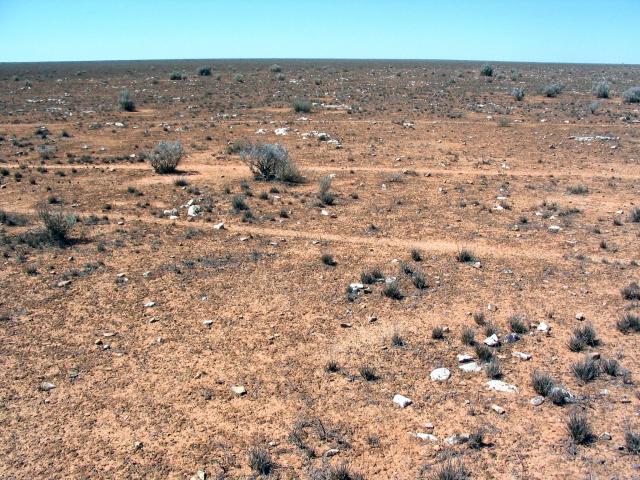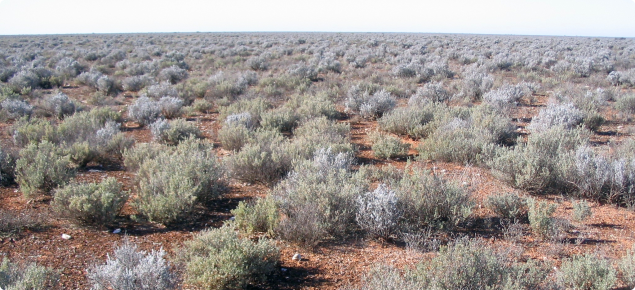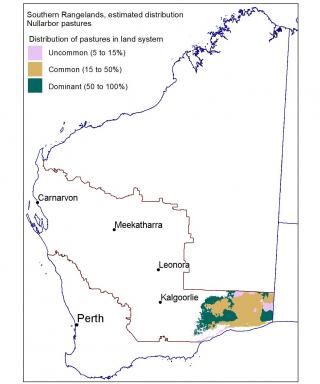Pastoral value – moderately high
The pastoral value of the Nullarbor pastures is moderately high because they support an abundance of palatable chenopods when in good condition plus palatable grass during favourable winter seasons. The prolific growth of speargrass can obscure the shrubs in some seasons. This has misled some observers to overestimate the productivity of the region for grazing. Provision of reliable sources of fresh water is difficult on these pastures and is a major limitation to development.
In the north, donga groves provide a more valuable source of forage than the surrounding plains. The improved soil moisture retention provides favourable conditions for a diverse variety of perennial trees, shrubs and annual herbs. The deterioration of donga groves leads to a reduction in the overall carrying capacity of the landscape as it loses ability to support herbivores during dry periods.
Suggested levels of use (per annum)
Table 1 provides a rough guide to the range of pastoral values for good condition pastures, which must be checked against conditions in each region and paddock. Carrying capacities for fair condition pastures might be 75% to 50% of good, and poor condition pastures less than 50% of good.
See Introduction to pastures in the southern rangelands of Western Australia for an explanation of how carrying capacities are estimated.
| Condition | Carrying capacity ha/DSE 1 | Carrying capacity ha/CU 2 | Carrying capacity ha/AE3 |
|---|---|---|---|
| Good | 10–14 | 70–104 | 84–125 |
1 DSE is based on the feed energy required to maintain a 45 kilogram liveweight Merino wether with zero weight change, no wool growth additional to that included in maintenance, and walking 7 km/day. 1 DSE has an energy requirement of approximately 8.7 MJ ME/day.
2 CU in the southern rangelands is based on a 400 kg steer at maintenance and equivalent to 7 DSE.
3 AE is based on the feed energy to maintain a 450 kg Bos taurus steer 2.25 years of age, walking 7 kilometers each day. 1 AE has an energy requirement of approximately 73 MJ ME/day and equivalent to 8.4 DSE.
Management
Fires pose a major threat to the chenopod pastures of the Nullarbor. Frequent fires, rabbits and stock have altered many pastures that once supported extensive chenopod shrublands, causing them to transition into grasslands or herblands. Valuable bladder saltbush has been eliminated from some areas by fire. The grasslands are increasingly prone to fire, further reducing the chances of shrub re-establishment.
Bladder saltbush regeneration is by seed alone; therefore, grazing pressure must be reduced post-fire to minimise the risk of exhausting the seed bank. Pearl bluebush will tolerate a cool fire, but recovery is slow; it can be killed by a hot fire. Regeneration is difficult and usually requires a number of consecutive favourable seasons. Western myall is also sensitive to fire. Young myalls (less than 20 years old) are vulnerable to grazing. Regeneration of western myall is also restricted if rabbits are present.
Overgrazing exposes the surface to wind erosion. Water erosion is not as much an issue because of the lack of coordinated drainage and karstic nature of the region’s geology.
Condition statement, Nullarbor pastures
Survey data show that Nullarbor pastures are predominantly in fair condition.
Good condition
Saltbush and bluebush are present at more than 1,800 pearl bluebush plants and more than 3,000 bladder saltbush plants per hectare (more than 18 and more than 30 per 100 m2) and there is a range of shrubs with mixed ages and sizes (Figure 1). Palatable grasses such as wallaby grass and cane speargrass are also common. Diverse herbs are present in season with good groundcover. There is a good variety and abundance of cryptogamic crusts. There is no erosion.
The structure and diversity of donga groves provide an indication of their condition. In good condition dongas support compact groves of tree-based clumps and associated palatable shrubs. They have an abundance of palatable grasses, such as Murchison red grass and neverfail.
Fair condition
Saltbush and bluebush are present at 1,000 to 1,800 pearl bluebush plants and 500 to 3,000 bladder saltbush plants per hectare (10 to 18 and 5 to 30 per 100 m2) (Figure 2). With the reduction in chenopods there may be a slight increase in seasonally dependent semi-perennials including less palatable bindiis and sidas. Groundcover may be reduced. Cryptogamic crusts are present but may not be well-developed. Minor erosion and redistribution of soil by wind may occur.
In fair condition donga groves there is a decline in the density of palatable species, often coinciding with an increase in curara. Prominent browse lines develop as a result of grazing. The replacement of grasses by short-lived herbs makes dongas susceptible to soil loss as they become more open and exposed to wind erosion.
Poor condition
Saltbush and bluebush shrubs are absent or very sparse, less than 1,000 pearl bluebush and less than 500 bladder saltbush per hectare (less than 10 and less than 5 per 100 m2), and juvenile shrubs may be absent (Figure 3). Speargrass may dominate between the bluebush mounds and the area may be transitioning into a Speargrass/wallaby grass pasture. Unpalatable annuals such as Ward’s weed, roly poly and violet twinleaf may be dominant. Annual growth is poor in average to below-average seasons. There is little or no cryptogamic crust. Erosion and redistribution of soil by wind is likely.
Poor condition dongas can be reduced to sparse stands of aged trees surrounded by undesirable annuals such as Ward’s weed and roly poly, and declared weeds such as Bathurst burr, doublegee and saffron thistle.



Vegetation structure and composition
Nullarbor pastures are predominantly pearl bluebush and bladder saltbush. Bluebush favours the rises and saltbush the depressions. Grasses such as speargrass are extremely common; neverfail and wallaby grass occur less frequently.
Higher rainfall areas to the south and west support medium and taller shrubs including false bluebush, broom bush, nitre bush and mingah bush. Trees such as the western myall, sugarwood and some eucalypts (often in mallee form) may also be present. Weeds such as Ward’s weed and roly poly have become established in some areas. Ward’s weed has some feed value when young. Onion weed is invading many pastures and becoming a problem.
The main indicator of condition is the density of the saltbushes and bluebushes. If land has been burned, the important shrubs may be replaced by grasses and annuals and may transition into speargrass/wallaby grass pastures. Unpalatable acacias, eremophilas and cassias may invade degraded areas. Soils of healthy Nullarbor pastures have well-developed cryptogamic crusts which improve nutrient cycling, soil moisture retention and provide protection against raindrop impact, sheet flow and wind erosion. The loss of cryptogamic crust is an indicator of deteriorated range condition. Table 2 has a list of the common and important species for this pasture group.
Occurrence
Nullarbor pastures occur in the geographically distinct Nullarbor region. They predominantly occur on the extensive undulating limestone plains associated with the Bunda Plateau, and to a lesser extent the northern portion of the Roe Plains. Soils are shallow calcareous loams, occasionally with limestone outcrop. Cryptogams are common. Rainfall run-off drains into large shallow depressions, before percolating through the limestone. Groundwater is generally deep (75–150 m) and often saline.
In the north of the Nullarbor, shallow, circular, closed depressions, locally referred to as dongas, intersperse the surrounding stony plains. They commonly have flat clay floors and can be up to several hundred metres across with gently sloped margins. They are zones of soil accumulation.
| Common name | Scientific name (links to FloraBase) | Desirability* |
|---|---|---|
| Bladder saltbush | D | |
| Cane speargrass | D | |
| Cotton bush | D | |
| Mingah bush, bullock bush | D | |
| Neverfail | D | |
| Scrambling saltbush | D | |
| Wallaby grass | D | |
| Woolly bindii | D | |
| Murchison red grass, mallee lovegrass | annual/D | |
| Broom bush | U | |
| Curara | U in dongas | |
| Grey cassia, desert cassia | U | |
| Limestone bindii | U | |
| Onion weed | U | |
| Silver cassia, banana-leaf cassia | U | |
| Spear-fruit copperburr | U | |
| Toothed saltbush | U | |
| Violet twinleaf | annual/U | |
| Roly poly | annual/U | |
| Ward’s weed | annual/U | |
| Berrigan | I | |
| False bluebush | I | |
| Grey fan leaf | I | |
| Limestone bindiis | Sclerolaena spp. | I |
| Native willow | I | |
| Nitre bush | Nitraria billardierei | I |
| Old man saltbush | I | |
| Pearl bluebush | I | |
| Sidas | Sida spp. | I |
| Speargrass | I | |
| Sugarwood | I | |
| Waterbush | I | |
| Western myall | I | |
| Miljee | N |
* D = desirable, U = undesirable, I = intermediate, N = no indicator value


